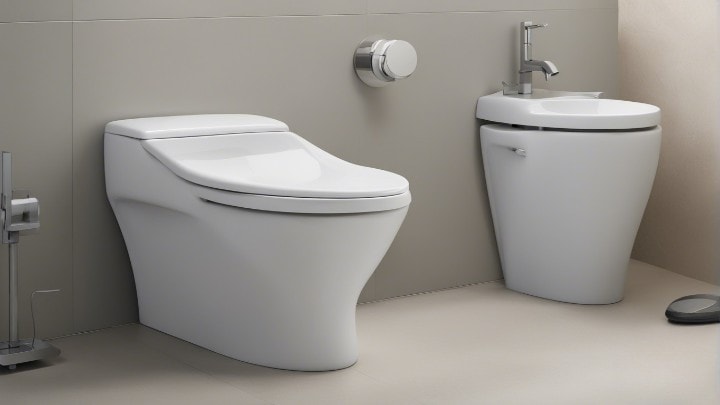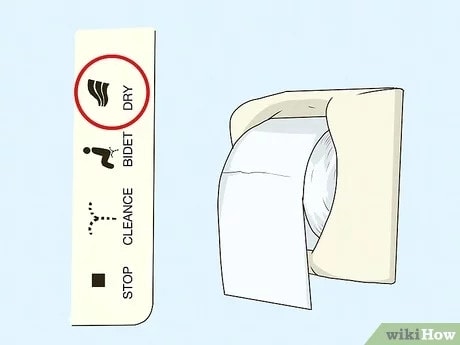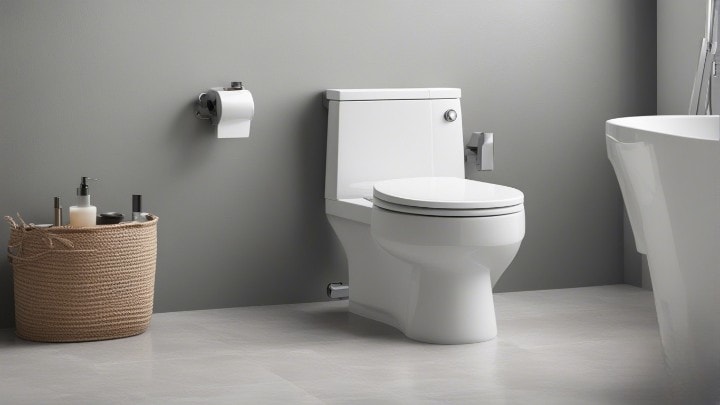Ever felt a bit ‘meh’ about your current bathroom hygiene routine? 🤔 You’re not alone.
Many feel that same itch, yearning for a touch more freshness.
Aha!
Enter the bidet, our unsung hero of personal cleanliness. 🚿 It’s not just a fancy French word, but a game-changer in bathroom rituals around the globe!
You may ask, “Why bidets?” 🤷♀️ Well, they offer a cleaner, more eco-friendly solution to our ‘clean-up’ woes.
Curious?
Yeah, we thought so.
Let’s journey through the fantastic world of bidets together, shall we? 🌍🚀 It’s time to freshen up your knowledge!
Table of Contents
Historical Evolution
Bidets, a French invention, emerged as a plumbing fixture primarily designed for washing the genitalia, anal area, and feet.
Their inception can be traced back to the early European aristocracy, where they were seen as a symbol of luxury and personal hygiene.
Over time, the bidet’s primary function shifted from a mere foot basin to an essential tool for genitalia wash and anal cleansing.
Evolution over Centuries
From their humble beginnings as simple basins, bidets have undergone significant transformations.
The bidet history reveals a journey from manual basins to the introduction of the bidet shower, a hand-held nozzle, which offered a more targeted cleaning approach.
As plumbing advanced, the traditional bidet evolved into the toilet attachment, providing users with a more integrated experience.
The electronic bidet, a modern marvel, came into the scene offering features like warm water option and self-cleaning mechanisms, making the bidet usage even more convenient and hygienic.
Cultural Acceptance
Bidets, over the years, have seen varied levels of acceptance across different cultures.
In Europe, especially places like Italy and France, bidets became a staple in bathrooms, symbolizing a commitment to personal hygiene.
Asia, with countries like Japan, embraced the bidet, integrating advanced technology to enhance the user experience.
However, in regions like America, bidets took time to gain popularity, often misconceived as a luxury rather than a necessity.
Cultural and religious beliefs also played a role in bidet acceptance, with some viewing it as a purification tool, especially in the Middle East.
Types of Bidets 🚿
Here are some major types of bidets.
Standalone Bidets

Standalone bidets, a classic French invention, are separate fixtures placed next to the toilet.
They’ve been around since the late 1600s, initially serving the European elite.
These bidets were simple basins without running water, requiring users to squat over them.
The name “”bidet”” translates to “”little pony”” in French, hinting at how one would straddle it.
Over time, these evolved, integrating running water and sprayers for a more refined experience.
They’re like the OGs of the bidet world, offering a dedicated space for personal hygiene.
Bidet Attachments
Bidet attachments are the modern-day solution for those not wanting to install a separate fixture.
They’re added directly to your existing toilet, turning it into a bidet in no time.
These attachments are a testament to the bidet’s adaptability, ensuring that everyone can experience the benefits without a complete bathroom overhaul.
Plus, they’re a wallet-friendly option for those wanting to test the waters (pun intended) before diving deep into the world of bidets.
Bidet Showers
Also known as hand-held nozzles, bidet showers offer a targeted cleaning approach.
They’re a popular choice in many parts of Asia and are reminiscent of the showerheads we use.
With a squeeze of the handle, you can control the water flow, ensuring you get a thorough clean.
They’re flexible, easy to use, and a favorite for those who like to be in control.
Electronic Bidets

The crème de la crème of bidets, electronic bidets are the epitome of luxury and convenience.
Originating post-WWII in Japan, these bidets combine the traditional toilet with advanced features.
Think warm water washes, heated seats, air dryers, and even remote controls.
They’re the future, today.
And with the increasing demand, they’re becoming more accessible to everyone.
Functionalities & Features
Bidets, with their rich history and widespread acceptance, have evolved to offer a plethora of functionalities and features.
Let’s delve into the core features that make bidets a must-have in modern bathrooms.
Basic Washing
The primary purpose of a bidet is to provide a thorough wash after using the toilet.
This feature ensures enhanced personal hygiene, reducing the reliance on toilet paper.
It’s like having a mini-shower for your nether regions, ensuring you feel fresh and clean after every use. 🚿
Temperature Control
Gone are the days when you had to brace yourself for a cold splash!
Modern bidets come equipped with temperature control, allowing users to adjust the water temperature to their liking.
Whether you prefer a warm, soothing wash or a cool, refreshing rinse, bidets have got you covered. 🌡️
Self-cleaning
Bidets are designed to be hygienic, and what better way to ensure this than a self-cleaning feature?
Many bidets come with nozzles that automatically clean themselves before and after use, ensuring that every wash is sanitary and free from contaminants. 🧼
Advanced Features
Electronic bidets, especially those from Japan and other parts of Asia, come packed with advanced features.
From heated seats and air dryers to deodorizers and even remote controls, these bidets offer a luxurious experience.
Imagine stepping off a bidet with a warm, dry bum, all without using a shred of toilet paper! 🎮
To give you a clearer picture, let’s compare the features across different bidet types:
| Feature | Standalone Bidets | Bidet Attachments | Bidet Showers | Electronic Bidets |
|---|---|---|---|---|
| Basic Washing | ✅ | ✅ | ✅ | ✅ |
| Temperature Control | ❌ | 🔄 (Some models) | ❌ | ✅ |
| Self-cleaning | ❌ | 🔄 (Some models) | ❌ | ✅ |
| Advanced Features | ❌ | ❌ | ❌ | ✅ |
🔄: Available in some models
So, as you can see, while all bidets offer the basic washing feature, electronic bidets truly stand out with their range of advanced functionalities.
Cultural Perspectives
Let’s discuss the cultural perspectives of bidets.
Bidets in Europe 🌍
Europe, the birthplace of the bidet, has a rich history intertwined with this plumbing marvel.
Originating as a French invention, bidets were initially a symbol of luxury and personal hygiene among the European elite.
Over the years, countries like Italy and France have embraced bidets as a bathroom staple, emphasizing their commitment to cleanliness.
In these regions, bidets aren’t just about hygiene; they’re a cultural norm.
- France: The homeland of bidets. Here, they’re as common as croissants in a bakery. From luxury hotels to countryside homes, bidets are an integral part of the French bathroom experience.
- Italy: Italians love their pasta, and they love their bidets! It’s not uncommon to find bidets in most Italian homes, emphasizing the importance of personal hygiene in their daily routines.
Bidets in Asia 🌏
Asia, with its blend of tradition and technology, has a unique relationship with bidets.
Countries like Japan have not only accepted but innovated the bidet experience.
- Japan: The land of sushi and samurais has revolutionized the bidet game. Electronic bidets, with features like warm water washes and heated seats, are a common sight in Japanese homes and public restrooms. It’s not just about cleanliness; it’s about comfort and luxury.
- Middle East: In regions where purification and cleanliness hold religious significance, bidets are seen as more than just a hygiene tool. They’re a part of daily rituals, ensuring one’s cleanliness before prayers.
Acceptance in the US 🌎
The US had a slow start in the bidet race.
Often misconceived as a luxury rather than a necessity, bidets took their sweet time to gain popularity.
But as environmental concerns grew and the benefits of bidets became more apparent, the US began warming up to the idea.
Today, modern bathrooms in the US are increasingly featuring bidets, marking a shift in perception from luxury to essential.
- Perception Shift: From Hollywood celebrities endorsing bidets to environmentalists highlighting their eco-friendly benefits, the US is gradually seeing a bidet boom.
It’s not just about being fancy; it’s about embracing a cleaner, greener future.
Environmental Impact of Bidets 🌿
Bidets, beyond their obvious hygiene benefits, have been making waves in the environmental sector.
Their rise in popularity isn’t just due to the personal cleanliness they offer, but also because of the significant positive impact they have on our environment.
Let’s dive into the environmental perks of using bidets.
Water Conservation 💧

One of the primary environmental benefits of bidets is water conservation.
While it might seem counterintuitive, considering bidets use water for cleaning, the amount of water used by a bidet is significantly less than what’s required to produce toilet paper.
- Fact Check: Producing a single roll of toilet paper requires about 37 gallons of water.
In contrast, a bidet uses approximately 1/8th of a gallon per clean.
Over time, the water savings are substantial, especially when you consider the reduction in toilet paper usage.
Reduction in Toilet Paper Use 🧻

Speaking of toilet paper, the environmental impact of its production is more significant than most realize.
From deforestation to the energy and water used in its creation, the environmental footprint is hefty.
- Did You Know?: The average American family spends roughly $120 a year on tissue paper.
By using a bidet, not only do you save money, but you also contribute to saving trees and reducing the carbon footprint associated with toilet paper production and transportation.
Hygiene Benefits 🌺
While not directly an environmental benefit, the hygiene advantages of bidets can’t be overlooked.
They offer a more thorough cleaning compared to toilet paper, reducing the risk of infections and promoting overall personal health.
A healthier population means less strain on healthcare resources, indirectly benefiting the environment.
- Quick Tip: For those concerned about water wastage, consider using bidet sprayers or electronic bidets with eco modes.
These options use minimal water while ensuring maximum cleanliness.
Installation & Maintenance
Installing a bidet can be a straightforward process, especially with the modern attachments and bidet seats available today.
Most bidet attachments fit standard toilets, making the DIY installation process relatively simple:
- Turn Off the Water: Always start by turning off the water supply to your toilet.
- Remove Your Existing Toilet Seat: Using a screwdriver, remove your current toilet seat.
- Place the Bidet Attachment: Position the bidet attachment on the toilet. Ensure it aligns with the mounting holes.
- Reattach the Toilet Seat: Place your toilet seat back on top of the bidet attachment and secure it with screws.
- Connect to Water Supply: Attach the provided T-adapter to your toilet’s water supply valve. Then, connect one end of the bidet hose to the T-adapter and the other end to the bidet attachment.
- Test: Turn the water supply back on and test the bidet to ensure there are no leaks and it functions correctly.
Professional Installation 🧰

While DIY installation is feasible for most, some might prefer a professional touch, especially for standalone bidets or advanced electronic models.
Hiring a plumber ensures:
- Proper alignment and secure fit.
- Correct water pressure settings.
- Assurance against potential leaks.
- Expertise in handling complex bidet models with electrical components.
Cleaning & Maintenance Tips 🧼
Maintaining your bidet ensures longevity and optimal performance.
Here are some tips:
- Regular Cleaning: Clean your bidet once a week using mild soap and a soft cloth. Avoid abrasive cleaners that can damage the surface.
- Nozzle Care: If your bidet has a self-cleaning feature, activate it regularly. For others, gently wipe the nozzle with a soft cloth.
- Check Connections: Periodically check the hose and T-adapter for any signs of wear or leakage.
- Filter Replacement: If your bidet has a filter, replace it as recommended by the manufacturer.
- Descale: In areas with hard water, descale your bidet periodically to prevent mineral buildup.
Remember, a well-maintained bidet not only ensures personal hygiene but also offers a comfortable and refreshing experience every time.
Modern Innovations

In the ever-evolving world of bidets, the modern era has ushered in a wave of innovations that have transformed the way we perceive and use these hygiene marvels.
Let’s take a closer look at some of the groundbreaking advancements in bidet technology.
Smart Bidets 🧠
Bidets have gone digital!
Smart bidets, like the Wiki Wall-Hung Bidet, are designed with the user’s comfort and convenience in mind.
These bidets come equipped with sensors, touchless operations, and even smartphone integration.
Imagine adjusting the water temperature or spray intensity with just a tap on your phone!
It’s not just about cleanliness anymore; it’s about experiencing luxury every time you use it.
Health Monitoring Features 🌡️
The future of bidets is not just about cleaning but also about health monitoring.
Some advanced bidets now come with features that can analyze waste to detect potential health issues.
These bidets can measure aspects like glucose levels, hydration, and even signs of infections.
It’s like having a mini health check-up every time you visit the bathroom!
Design Innovations 🎨
Bidets have come a long way from their traditional designs.
Modern bidets, especially wall-hung models, offer a sleek and space-saving solution for contemporary bathrooms.
Brands like Wiki have introduced wall-hung bidets that seamlessly blend with the bathroom aesthetics, ensuring that functionality doesn’t compromise style.
Denouement!
In the grand tapestry of bathroom evolution, bidets have emerged as the shining stars, blending hygiene, luxury, and environmental consciousness.
From their aristocratic French origins to the tech-savvy marvels of today, bidets have redefined our bathroom experiences.
Whether you’re an eco-warrior, a hygiene enthusiast, or simply someone who loves a touch of luxury, the bidet beckons.
So, the next time you think of leveling up your bathroom game, remember: the future isn’t just smart homes; it’s smart bathrooms.
Dive into the refreshing world of bidets and let the revolution begin! 🚿🌍🌟
FAQs
What is a bidet used for?
A bidet is used for cleaning the genital and anal areas after using the toilet. It provides a stream of water to assist in personal hygiene.
Why are bidets taboo?
Bidets are considered taboo in some cultures due to cultural norms, lack of exposure, or misconceptions about their use and hygiene benefits.
Are bidets hygienic?
Yes, bidets are hygienic. They offer a water-cleaning method that can be more effective and gentle than using toilet paper alone.
What percentage of people have a bidet?
The percentage varies by country, but in many European and Asian countries, a significant portion of households have bidets. In the US, they are less common but gaining popularity.
Which countries are bidet friendly?
Countries like Japan, Italy, Spain, and France are known to be bidet-friendly, with a high prevalence of bidets in households and public restrooms.
What are modern innovations in bidets?
Modern innovations in bidets include features like heated seats, adjustable water temperature and pressure, air dryers, and self-cleaning nozzles.


